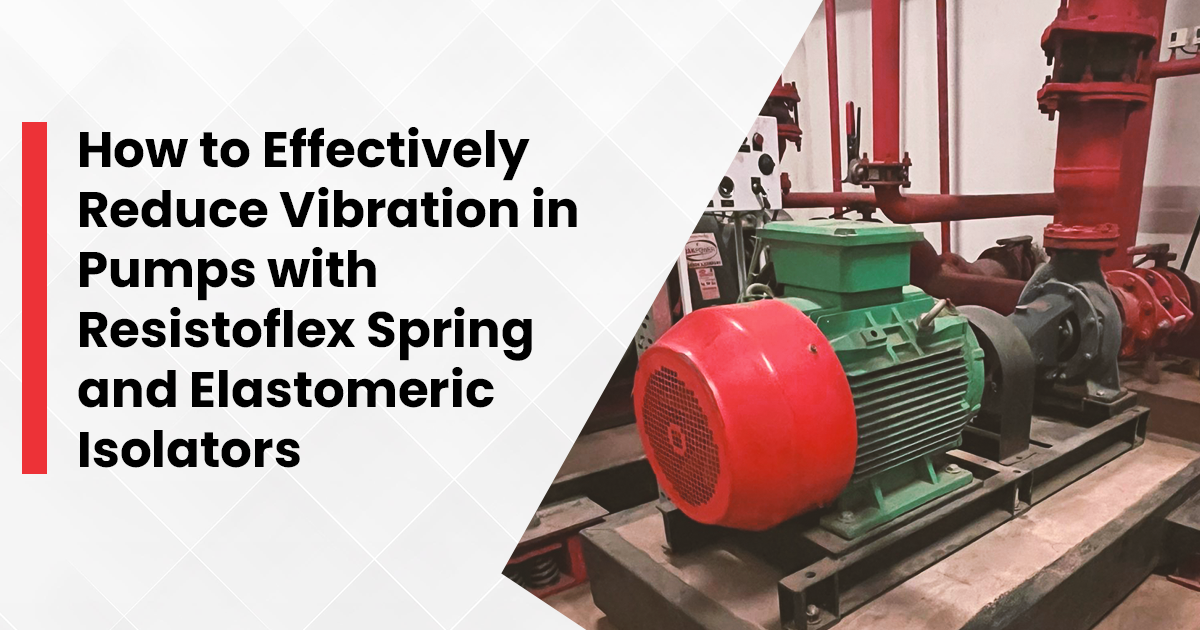Reduce Pump Vibration with Resistoflex Isolators
- 20 May 2025
- Reduce Pump Vibration with Resistoflex Isolators
How to Effectively Reduce Vibration in Pumps with Resistoflex Spring and Elastomeric Isolators

Introduction
In any industrial or HVAC setup, pumps are critical components for fluid movement. However, they are also common sources of unwanted vibration. If left unmanaged, these vibrations can cause increasing structural wear and tear and ultimately lead to premature equipment failure. In systems where precision and durability are paramount, vibration isolation is not just a recommendation - it’s a necessity.
This blog explores how spring and elastomeric isolators, specifically from Resistoflex, offer a reliable approach to reduce pump vibrations. It also highlights the key products and implementation strategies for optimized performance of the equipment.
Understanding Pump Vibrations: A Technical Overview
Pump vibrations result from a range of mechanical and hydraulic phenomena. The most common sources include:
-
Mechanical Imbalance
Imperfect mass distribution in rotating components causes centrifugal forces that generate continuous oscillations during operation. -
Hydraulic Disturbances
Turbulence and pressure variations in fluid flow introduce dynamic forces that act on the pump housing and support structures. -
Structural Resonance
If a pump's operating frequency aligns with the system’s natural frequency, even small excitation forces can amplify vibration. -
Misalignment and Looseness
Improper shaft alignment and worn or loosened components can significantly increase vibratory motion over time.
Consequences of Uncontrolled Vibration
When pump vibrations are not adequately controlled, they often lead to:
- Increased noise levels
- Accelerated wearing of rotating parts
- Structural damage to foundations or piping
- Inefficiencies in fluid handling
- Frequent maintenance and operational downtime
Mitigating these effects through proper vibration isolation equipment improves the longevity and reliability of the pump system.
Vibration Isolation Using Resistoflex Solutions
Resistoflex provides specialized vibration control products engineered for effective performance in pump applications. Below is an overview of their key offerings:
-
Fleximount
Rubber Isolator – Type FM
This isolator offers multi-directional vibration control in a compact form factor. Key features include:- Up to 95% isolation efficiency
- Installation without grouting
- Minimal maintenance requirements
-
Genflex Rubber
Mounting
Genflex mountings are designed to handle dynamic pump loads with enhanced damping. The inclined rubber elements provide:- Higher deflection than conventional pads
- Improved damping of low-frequency vibrations
- Resistance to oil, grease, and environmental contaminants
-
Inertia Pouring
Frame with Open Spring Mounts (for Non Seismic
Zones)
This configuration combines high-quality steel springs with a rigid isolator positioning frame. It ensures:- Vertical deflection for low-frequency vibration isolation
- 60% saving on foundation costs
- Adjustable leveling capability during installation
- Improved safety and stability under varying load conditions
-
IPF with Seismic
Restrained Spring Mount (Seismic Zones)
Designed specifically for seismic zones, these mounts integrate restraint mechanisms that comply with seismic requirements. Features include:- Multi-directional movement restriction during seismic events
- Simultaneous vibration isolation under normal operation
- Long-term durability and mechanical integrity
Best Practices for Effective Vibration Control
To achieve optimal performance and reliability from vibration isolators, consider the following technical guidelines:
-
Operating Speed
The operating speed of pumps is a function of vibration isolation. -
Load Distribution
Accurate weight calculations are crucial to ensure selection of isolators. Overloaded isolators may fail prematurely, while underloaded ones may not provide adequate isolation. -
Installation Accuracy
All isolators and pads must have full surface contact with the pump base and the foundation. Improper leveling or partial surface contact can reduce the effectiveness of vibration damping and introduce tilting forces. -
Seismic Safety
In regions prone to seismic activity, isolators are selected based on the specific seismic zone. Restrained spring mounts are recommended to prevent equipment damage during earthquakes. -
Routine Inspection and Maintenance
Check all isolators regularly for signs of deformation or environmental degradation. Periodically, replace components exposed to chemical spills or UV degradation.
Conclusion
Pump vibration isolation is an essential component of system design in industrial and HVAC industries. The selection and proper installation of high-quality spring and elastomeric isolators can significantly enhance system stability, reduce noise, and prolong the life of both pumps and associated machinery.
Resistoflex offers a robust and wide range of products tailored for reducing the vibration. These solutions are grounded in proven engineering and offer long-term reliability.
To learn more or consult with an expert, visit: 👉 Resistoflex Spring and Elastomeric Isolators


